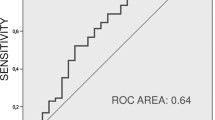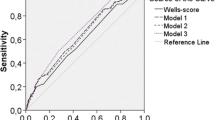Abstract
The purpose of this work is to question the conventional theory that all pulmonary emboli (PE) are abnormal, and to test the hypothesis that small peripheral PE are a function of life. Most radiologists report any filling defect, independent of size, as clinically significant PE when detected in the pulmonary arteries. We sought to reinforce the theory that small dots in the pulmonary arteries are not clinically significant clots in the conventional setting. The necessity for anticoagulation should be balanced against the risk of bleeding. This retrospective HIPAA-compliant study was approved by the institutional review board; informed consent was not required. All patients diagnosed with PE by 16-slice or 64-slice multidetector computed tomography (CT) over a 6-month period who also had a lower extremity venous ultrasound (US) performed within 7 days of CT were identified. The study group included 26 women and 24 men (mean, 56 years; range, 21–90 years). The locations of the PE were plotted on a pulmonary arterial diagram, and width of the most proximal clot for each patient was measured. Of 1,273 consecutive CT studies, 101 were positive (7.9%) and 50 patients underwent lower extremity US. Thirty-three (66%) patients had PE in the central pulmonary arteries, of which 19 (58%) had deep vein thrombosis (DVT). Seventeen (34%) patients had peripheral PE; DVT was detected in 0 (0%) patients. The peripheral clots measured 1.0–3.8 mm (mean, 2.5 mm). These clots appeared focal and rounded with a “dot-like” appearance. Peripheral, focal filling defects in the pulmonary arteries, which we termed “dots,” are not traditional embolic clots, are not associated with detectable lower-extremity clot load, and may represent “normal” embolic activity originating from the lower extremity venous valves. We suggest that more in-depth understanding about small peripheral PE is needed. The necessity of conventional anticoagulation should be critically reviewed in patients with subsegmental PE and minimal clot burden.



Similar content being viewed by others
References
Silverstein MD, Heit JA, Mohr DN, Petterson TM, O’Fallon WM, Melton LJ 3rd (1998) Trends in the incidence of deep vein thrombosis and pulmonary embolism: a 25-year population-based study. Arch Intern Med 158:585–593
Anderson FA Jr, Wheeler HB, Goldberg RJ et al (1991) A population-based perspective of the hospital incidence and case-fatality rates of deep vein thrombosis and pulmonary embolism. The Worcester DVT study. Arch Intern Med 151:933–938
Office of the Surgeon General (2008) The Surgeon General’s call to action to prevent deep vein thrombosis and pulmonary embolism 2008. Office of the Surgeon General Web site. http://www.surgeongeneral.gov/topics/deepvein/calltoaction/call-to-action-on-dvt-2008.pdf. Accessed 13 April 2009 (Published September 15, 2008)
Qanadli SD, Hajjam ME, Mesurolle B et al (2000) Pulmonary embolism detection: prospective evaluation of dual-section helical CT versus selective pulmonary arteriography in 157 patients. Radiology 217:447–455
Winer-Muram HT, Rydberg J, Johnson MS et al (2004) Suspected acute pulmonary embolism: evaluation with multi-detector row CT versus digital subtraction pulmonary arteriography. Radiology 233:806–815
Stein PD, Fowler SE, Goodman LR et al (2006) Multidetector computed tomography for acute pulmonary embolism. N Engl J Med 354:2317–2327
Schoepf UJ, Holzknecht N, Helmberger TK et al (2002) Subsegmental pulmonary emboli: improved detection with thin-collimation multi-detector row spiral CT. Radiology 222:483–490
Ghaye B, Szapiro D, Mastora I et al (2001) Peripheral pulmonary arteries: how far does multidetector-row spiral CT allow analysis? Radiology 219:629–636
Patel S, Kazerooni EA, Cascade PN (2003) Pulmonary embolism: optimization of small pulmonary artery visualization at multi-detector row CT. Radiology 227:455–460
Burge AJ, Freeman KD, Klapper PJ, Haramati LB (2008) Increased diagnosis of pulmonary embolism without a corresponding decline in mortality during the CT era. Clin Radiol 63:381–386
Winston CB, Wechsler RJ, Salazar AM, Kurtz AB, Spirn PW (1996) Incidental pulmonary emboli detected at helical CT: effect on patient care. Radiology 201:23–27
Gosselin MV, Rubin GD, Leung AN, Huang J, Rizk NW (1998) Unsuspected pulmonary embolism: prospective detection on routine helical CT scans. Radiology 208:209–215
Storto ML, Credico AD, Guido F, Larici AR, Bonomo L (2005) Incidental detection of pulmonary emboli on routine MDCT of the chest. AJR 184:264–267
Ritchie G, McGurk S, McCreath C, Graham C, Murchison JT (2007) Prospective evaluation of unsuspected pulmonary embolism on contrast enhanced multidetector CT (MDCT) scanning. Thorax 62:536–540
Wu AS, Pezzullo JA, Cronan JJ, Hou DD, Mayo-Smith WW (2004) CT pulmonary angiography: quantification of pulmonary embolus as a predictor of patient outcome—initial experience. Radiology 230:831–835
Cronan JJ (1993) Venous thromboembolic disease: the role of US. Radiology 186:619–630
Gurney JW (1993) No fooling around: direct visualization of pulmonary embolism. Radiology 188:618–619
Stein PD, Anthanasoulis C, Alavi A et al (1992) Complications and validity of pulmonary angiography in acute pulmonary embolism. Circulation 85:462–468
Novelline RA, Baltarowich OH, Athanasoulis CA et al (1978) The clinical course of patients with suspected pulmonary embolism and a negative pulmonary arteriogram. Radiology 126:561–567
Goodman LR (2005) Small pulmonary emboli: what do we know? Radiology 234:654–658
Remy-Jardin MR, Pistolesi M, Goodman LR et al (2007) Management of suspected acute pulmonary embolism in the era of CT angiography: a statement from the Fleischner Society. Radiology 245:315–329
Linkins LA, Choi PT, Douketis JD (2003) Clinical impact of bleeding in patients taking oral anticoagulant therapy for venous thromboembolism. Ann Intern Med 139:893–900
Author information
Authors and Affiliations
Corresponding author
Rights and permissions
About this article
Cite this article
Suh, J.M., Cronan, J.J. & Healey, T.T. Dots are not clots: the over-diagnosis and over-treatment of PE. Emerg Radiol 17, 347–352 (2010). https://doi.org/10.1007/s10140-010-0863-1
Received:
Accepted:
Published:
Issue Date:
DOI: https://doi.org/10.1007/s10140-010-0863-1




